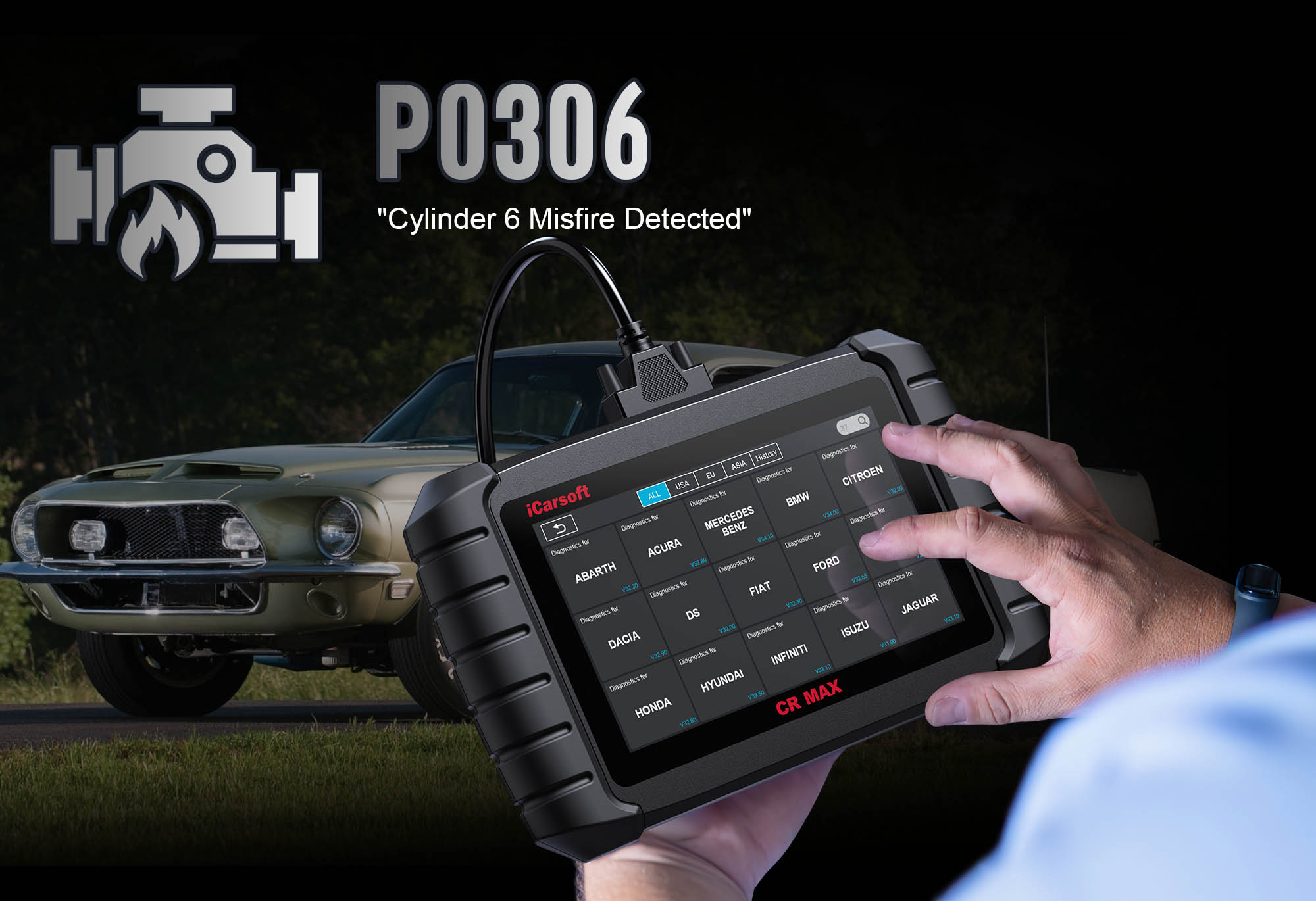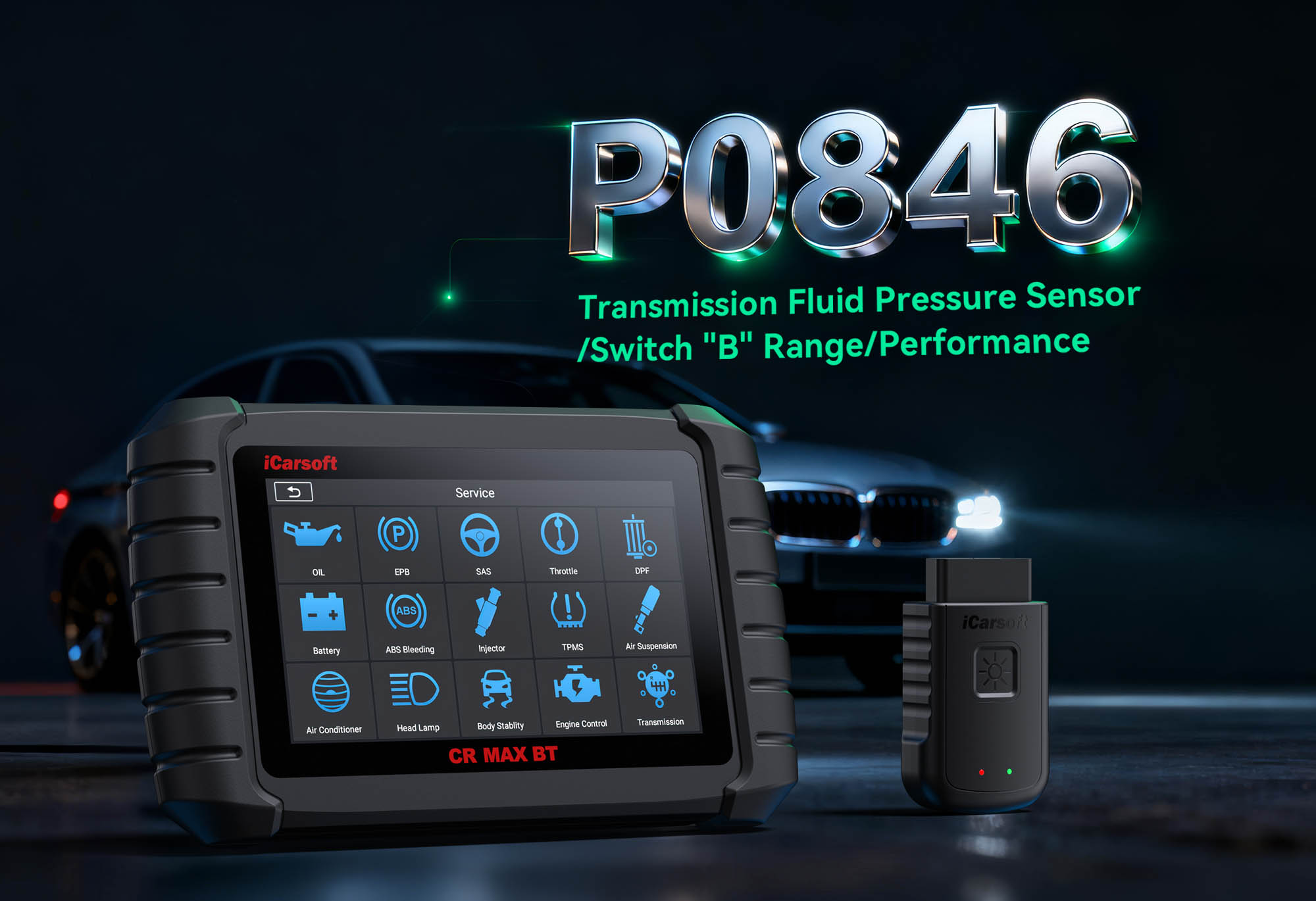Understanding OBD-II Code P0306: Cylinder 6 Misfire – Symptoms, Causes & Solutions
As an experienced automotive diagnostic resource, we frequently encounter OBD-II error codes like P0306—"Cylinder 6 Misfire Detected." This guide serves as a practical, step-by-step reference to identify symptoms, pinpoint root causes, and implement lasting fixes. Whether you’re a DIY enthusiast or professional technician, we’ll also highlight how the iCarsoft CR MAX diagnostic tool streamlines diagnosis, and how CR MAX ignition parts can prevent recurring misfires.
What Is the P0306 Code?
The P0306 code is a generic OBD-II diagnostic trouble code triggered when the Powertrain Control Module (PCM) detects incomplete combustion in Cylinder 6. This means the cylinder isn’t firing properly—either due to missing spark, insufficient fuel, or poor compression.
A critical note: Cylinder numbering (which one is "6") varies by engine layout:
-
Inline engines (4/6-cylinder): Numbering starts at the front (closest to the radiator) and goes to the rear.
-
V6/V8 engines: "Bank 1" (where Cylinder 1 is located) and "Bank 2" determine sides—use the iCarsoft CR MAX’s Component Location feature to confirm your vehicle’s exact cylinder map (avoids costly misdiagnosis).
Common Symptoms of P0306 (Cylinder 6 Misfire)
P0306 causes noticeable performance issues that worsen over time. Watch for these key signs:
Illuminated Check Engine Light (CEL)
The light may flash (severe misfire) or stay solid—flashing indicates immediate risk of catalytic converter damage.
Rough Idle/Vibration
Engine shakes noticeably at idle (500–800 RPM), often felt through the steering wheel or seat.
Power Loss & Hesitation
Sluggish acceleration, especially at high RPM; engine "stumbles" when pressing the throttle.
Poor Fuel Economy
MPG drops by 10–20%—unburned fuel in Cylinder 6 forces the engine to work harder.
Unusual Exhaust Noises
Popping, backfiring, or a "sputtering" sound from the exhaust—signs of unburned fuel igniting in the catalytic converter.
Why You Should Address P0306 Immediately
Ignoring a Cylinder 6 misfire leads to cascading damage and higher repair costs:
-
Catalytic Converter Failure: Unburned fuel heats the converter to 2,000°F+, melting internal components (repair cost: $800–$2,500).
-
Engine Overheating: Misfires disrupt normal combustion, causing localized hot spots that damage gaskets or valves.
-
Worsening Mechanical Damage: Low compression (a common P0306 cause) can lead to bent valves or piston ring failure if left unaddressed.
-
Emissions Test Failure: High unburned hydrocarbon (HC) levels will cause your vehicle to fail state emissions tests.
Diagnosing a Cylinder 6 Misfire: How to Diagnose P0306 Misfire
Systematic diagnosis is key—skip steps, and you’ll waste time replacing good parts. Use the iCarsoft CR MAX to streamline each phase:
-
Scan & Confirm P0306 (and Related Codes)
-
Plug the CR MAX into your vehicle’s OBD-II port, power it on, and select your make/model/year (use AutoVIN for accuracy).
-
Navigate to Engine Control Module > Fault Codes > Read Codes to confirm P0306.
-
Check for related codes (e.g., P0300 for "random misfire," P0206 for "Fuel Injector 6 Circuit Fault")—these narrow down the cause.
-
Inspect Ignition Components (Spark Plug & Coil)
Ignition system failures cause 60% of P0306 cases. Here’s how to test:
-
Locate Cylinder 6’s spark plug and ignition coil using the CR MAX’s Component Location guide.
-
Remove the spark plug: Look for wear (eroded electrodes), oil fouling (wet, black deposits), or carbon buildup (dry, sooty deposits)—all indicate a faulty plug.
-
Test the ignition coil: Use the CR MAX’s Multimeter > Resistance Test to check primary (0.5–2 ohms) and secondary (8,000–15,000 ohms) resistance—values outside this range mean a bad coil.
Real-World Tip (From Reddit User): "I swapped the ignition coil from Cylinder 6 to Cylinder 4, then rescanned with the CR MAX. The misfire code changed to P0304—proof the coil was faulty, not the cylinder itself. Replaced the coil, and P0306 was gone."
-
Evaluate Fuel Delivery (Fuel Injector for Cylinder 6)
A clogged or failed fuel injector starves Cylinder 6 of fuel. Use the CR MAX to test:
-
Navigate to Special Functions > Fuel System > Injector Balance Test—the CR MAX compares fuel flow across all cylinders. A low reading for Cylinder 6 = faulty injector.
-
Check injector wiring: Use the CR MAX’s Continuity Test to ensure no breaks between the injector and PCM.
-
If wiring is good, clean the injector with specialized fuel injector cleaner—replace if cleaning doesn’t restore flow.
-
Check for Vacuum Leaks
Unmetered air entering the intake manifold near Cylinder 6 disrupts the air-fuel mixture. Here’s how to find leaks:
-
Use the CR MAX’s Live Data to monitor Short-Term Fuel Trim (STFT)—values above +10% indicate a vacuum leak.
-
Visually inspect intake hoses, gaskets, and the EGR valve for cracks or loose connections. Spray a small amount of soapy water on suspect areas—bubbles = leak.
-
Repair leaks with new hoses/gaskets; use high-temp RTV sealant for intake manifold gaskets.
-
Perform Compression Testing
Low compression (mechanical issues) causes persistent P0306. While the CR MAX doesn’t perform compression tests directly, it helps:
-
Use Live Data > Engine RPM to ensure the engine idles steadily during manual compression testing (unsteady RPM = inconsistent compression).
-
Manual test steps: Remove all spark plugs, disable fuel injection, and connect a compression tester to Cylinder 6. Crank the engine—normal compression: 120–190 psi.
-
Low compression = Worn piston rings, bent valves, or a blown head gasket (consult a mechanic for further teardown).
-
Review Sensor Data
Faulty sensors can trick the PCM into causing a misfire. Use the CR MAX to monitor:
-
Crankshaft Position Sensor (CKP): Ensures proper cylinder timing—erratic CKP data in Live Data = sensor failure.
-
Mass Air Flow (MAF) Sensor: Incorrect airflow readings disrupt fuel mix—use Waveform Analysis to check for irregular signals.
-
Throttle Position Sensor (TPS): Stuck TPS values cause uneven fuel delivery—replace if readings don’t change with throttle input.
Common Causes of P0306
Based on diagnostic data and user reports, these are the most frequent triggers of P0306 (ordered by likelihood):
-
Ignition System Failures (60%): Worn spark plugs (over 30,000 miles), faulty ignition coils, or damaged ignition wires (in older vehicles with distributors).
-
Fuel Injector Issues (20%): Clogged injectors (from low-quality fuel) or electrical failure in the injector circuit.
-
Vacuum Leaks (10%): Cracked intake hoses, failed intake manifold gaskets, or leaking EGR valves.
-
Low Compression (8%): Worn piston rings, bent valves, blown head gaskets, or cylinder wall damage.
-
Sensor Failures (2%): Faulty CKP, MAF, or TPS sensors—rare, but easily ruled out with the CR MAX.
DIY Fixes & Recommendations
Once the CR MAX identifies the cause, use these targeted fixes:
-
Replace Ignition Components
-
Replace Cylinder 6’s spark plug with a CR MAX-recommended OEM-compatible plug (iridium plugs last 60,000+ miles).
-
If the coil is faulty, replace it—for vehicles over 100,000 miles, replace all coils (prevents future misfires in other cylinders).
-
Clean/Replace Fuel Injector
-
Clean clogged injectors with a full-tank fuel injector cleaner (follow product instructions).
-
Replace the injector if cleaning doesn’t work—use the CR MAX’s Part Lookup to find the correct OEM part.
-
Repair Vacuum Leaks
-
Replace cracked intake hoses or worn gaskets—use silicone hoses for better durability.
-
Seal small leaks with high-temp RTV sealant (avoid blocking airflow passages).
-
Fix Sensor Faults
-
Replace faulty sensors (CKP, MAF, TPS) with OEM parts—generic sensors often cause recurring issues.
-
Use the CR MAX to reset the PCM after sensor replacement—clears old, faulty data.
CR MAX Ignition Parts: Reliable Upgrades to Prevent Misfires
When repairing P0306, choosing high-quality ignition parts is critical—cheap components fail quickly, leading to repeat misfires. CR MAX ignition parts are engineered for durability and performance:
Precision Ignition & Strong Spark
CR MAX spark plugs (iridium/platinum) and coils deliver consistent voltage, ensuring complete combustion in Cylinder 6.
Premium Materials
Iridium electrodes resist wear (last 60,000+ miles), while coils use heat-resistant casing to withstand engine bay temperatures.
Vehicle-Specific Fit
Designed to match OEM specs for your make/model—no modifications needed (CR MAX’s Part Lookup confirms compatibility).
Budget-Friendly
Offers OEM-level performance at 30–50% less cost than dealership parts.
Quick Checklist: P0306 Code Fix Guide Summary
|
Step
|
Action
|
|
1
|
Scan with iCarsoft CR MAX to confirm P0306 and related codes
|
|
2
|
Inspect Cylinder 6’s spark plug (wear/fouling) and ignition coil (resistance test)
|
|
3
|
Run CR MAX Injector Balance Test to check Cylinder 6’s fuel injector
|
|
4
|
Check for vacuum leaks (monitor STFT with live data; use soapy water test)
|
|
5
|
Perform manual compression test on Cylinder 6 (normal: 120–190 psi)
|
|
6
|
Replace faulty parts (use CR MAX ignition parts for durability)
|
|
7
|
Clear P0306 with CR MAX; test drive 20+ miles to confirm fix
|
Wrapping Up
The P0306 code may seem daunting, but with systematic diagnosis (powered by the iCarsoft CR MAX) and quality parts (like CR MAX ignition components), you can resolve it efficiently. Remember:
-
Start with the ignition system (most common cause) before moving to fuel or mechanical issues.
-
Use the CR MAX’s live data, component tests, and location guides to avoid guesswork.
-
Invest in durable parts—CR MAX ignition components prevent recurring misfires and save money long-term.
If compression testing reveals mechanical damage (e.g., bent valves), consult a professional mechanic—these issues require specialized tools. For all other causes, the CR MAX and this guide give you everything you need to fix P0306 and restore your vehicle’s performance.





